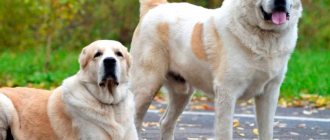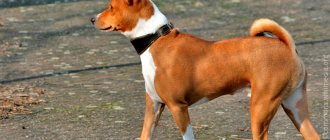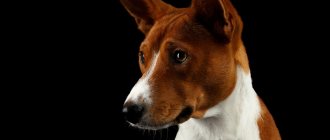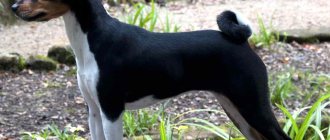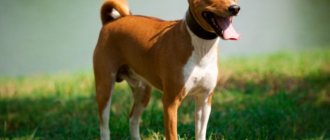So why don't Basenjis bark?
There are two theories about this.
- It is believed that these dogs were domesticated before they realized that they needed to bark. It turns out that, in theory, Basenjis can bark, but they don’t want to.
- The second theory talks about some structural features of the pharynx of these dogs. Because of this structure they cannot bark.
Scientists have not yet been able to give a more accurate answer.
But despite the absence of barking, Basenjis can make sounds
. Firstly, these are the famous “trills”, which is why they stand out so much among other dogs. But in addition, African silent ones can make very unpleasant sounds. More than once, the owners of these dogs have come home to find an ambulance and police at their door, trying to break into their houses. But the thing is that if the Basenji is worried, then they make sounds in which all the neighbors believe that someone nearby is dying in painful convulsions.
What Basenjis love is running. Running inspires these dogs and fills them with life. Therefore, if you decide to purchase this particular breed of dog, then think carefully about whether you can provide it with this need for running. Sometimes the gait of this breed of dog is compared to the walking of a horse. If this dog is forced to move little, it can lead to depression.
This dog is also called the “forest dog from the Congo.” In the countries of Belarus, Russia and Ukraine, this breed is still completely new and was introduced only in 1997. It will especially appeal to people who cannot prefer a dog or a cat. The forest dog from the Congo has a lot of feline features. She loves when people admire her, when people talk about her a lot and well, and washes her face with her paw. Just like a cat, she builds relationships with humans. Intimidation and suppression of personality will not work with her. Only positive reinforcement.
Another extremely positive quality: Basenjis are not aggressive towards people. But in the company of other dogs, they will always try to dominate.
At the end of the article, I suggest watching a video in which you can hear the howls and trills of a Basenji dog.
This is what a Basenji looks like
dog breeds we invite you to talk about Bassenji dogs. The rather exotic name of the breed suggests an interesting history of this breed - and, this is true. So, let's put our business aside and take a closer look at the Basenji - this dog has something to tell us about...
Owner reviews
This is an unusual and interesting breed of dog - the Basenji. Reviews from owners who have already had experience with animals indicate that this is perhaps one of the most difficult breeds to keep. These dogs are smart and easy to train, but it’s not easy to control their instincts. These dogs perfectly remember the rules of living in the house, but follow them like cats - when the owner insists.
Basenjis need long walks, and with physical activity, otherwise they will either destroy the apartment or get off the leash on the street, trying to give free rein to their irrepressible energy. Experienced gardeners advise: do not have a Basenji in a very small apartment. It will be equivalent to a cage for an animal.
But if you are fond of hunting, then this dog will be a good and reliable assistant. In addition, she will spend her energy in nature, and at home she will become an affectionate and cheerful companion.
History of the breed
The ancient Egyptians also knew about Basenji dogs. So, these dogs were given as a gift to the pharaohs, who, by the way, loved these dogs very much and even endowed them with special divine qualities, believing that Basenjis were an earthly amulet. Proof of this is the rock paintings of these dogs in the tombs of Egyptian pharaohs, and the found mummies of Basenji dogs, which were customary to be buried along with their noble owners in luxury and honor.
Also, they knew about Basenji in Nubia - this is the territory of the modern state of Sudan. Thus, in one of the ancient Nubian burials, the remains of a Basenji dog were discovered, which sits at the feet of its owner.
Today, Basenjis are the most popular African dogs that help Africans during hunting.
Basenjis came to Europe in 1895, thanks to English sailors, but the dogs did not take root there and died. The second attempt to introduce the Basenji to Europe was the appearance of this dog breed in 1905 at the Berlin Zoo. And, later, in 1930, the Basenjis again set out to conquer England - and this time they conquered it. It was the British who approved the Basenji breed standard, which is still relevant today. The first Basenji took part in a dog show in 1937, then in the column of the Basenji’s dog breed the name Congo Terrier was listed and everyone liked the dog so much that the owner of the Basenji began to be bombarded with offers to sell the dog, and with questions about where he brought such a miracle from...
Breeding
The pregnancy of an African husky female lasts 56-73 days - in terms of timing, everything is individual and does not depend on external signs. You need to feed your Basenji dog high-quality and high-calorie food in order to provide vitamins and nutrients to future offspring. The birth must be attended by a veterinarian, so you should agree with him in advance. After the birth of Basenji puppies, they and their mother need to continue to receive enhanced healthy nutrition.
After the puppies are 21 days old, they need to be dewormed (or “wormed”). An adult dog undergoes this procedure even before pregnancy.
From the age of two months, Basenji puppies must be vaccinated in accordance with their personal vaccination schedule. This is best done with imported medicines.
It is also necessary to carry out certification of Basenji puppies - this is an examination to control the breeding of animals. The head of the breed visits the owner’s home or kennel, assesses the well-being of the mother dog and examines her offspring. Next, a general card is created for all Basenji puppies and an individual card for each of them, which describes their appearance, the condition of the coat, teeth and bite of the animals. They also pay special attention to the living conditions and breeding conditions of dogs.
Egyptian origin story
The existence of the breed has lasted for more than 5-6 thousand years. However, the first evidence of domesticated Basenjis dates back to 3500 BC.
Back then, in Ancient Egypt, dogs were presented to the pharaohs as gifts. The Egyptians treated many animals with respect and the Basenji was no exception.
Numerous finds indicate the special status of the breed. In ancient tombs and burials there are often figurines, boxes and other objects made in the image of small dogs. Archaeologists have often found the mummified remains of Basenji ancestors buried at the feet of their owners. The Egyptians endowed dogs with supernatural powers. It was believed that Basenji was able to protect against dark forces and was a guide to the world of the gods.
With the end of slavery, the special popularity of the breed disappeared. The dogs were left to their own devices and began to lead a wild life. At the same time, they were taken into care by African tribes. Thanks to their developed hunting instinct, Basenjis have become faithful hunting companions for people. Along with excellent skills in pursuing prey, they also had good security qualities. Thus, the dogs began to serve as guards, notifying the tribe of the approach of predatory animals.
The Basenji lived their semi-wild existence until the middle of the 19th century. The first attempts to export the breed ended in failure - all individuals died after a long journey from Africa to Great Britain in 1895. By the beginning of the twentieth century, the breed was considered an exclusively wild species. They were kept in zoos in European countries. Only by the 1930s were English dog handlers able to successfully adapt the breed and begin serious work with it.
Salonga
A few years later, the Basenji first took part in an exhibition called “Congo Terrier”, since some of the individuals at that time were actively used by the tribes living in the territory of the modern Salonga Park (Republic of Congo). The first debut ended in success, which gave rise to their distribution throughout the world. In 1939, the first breed standard was published in England, and 2 years later several dogs were brought to the USA. The Basenji was brought to Russia at the end of the twentieth century.
Basenji Kennels
Buying a Basenji puppy online or at the market is not easy. The Basenji kennel is the place to go if you want to purchase a puppy of a specific breed. They provide all the necessary certificates, licenses and veterinary passports for dogs. The following nurseries operate in Russia:
- "Ituri Puzzle", Moscow.
- "Salonga", Moscow.
- "Lavera Solas", Kirov.
- "House The Rainbow", Moscow.
- "Eter's Legacy", Chelyabinsk.
- "African Silent Man", St. Petersburg.
Education and training
It is worth saying that this non-barking breed is suitable exclusively for people who have experience raising dogs. Stanley Coren, PhD, published an article on the intelligence of different breeds in which he ranked these dogs 78th out of 79, but based on the dogs' response to commands. Many dog handlers retort to him that Basenjis are simply quite stubborn ; they do not always respond to commands the first time.
The Basenji requires a lot of attention and an individual approach when training. The owner will have to overcome her stubbornness and put himself in the place of the leader of the pack. Learns well in a playful manner . Brute force during training is excluded. It is important to start training from the moment the puppy first gets into the house.
Sometimes they pointedly ignore people's instructions. Even after careful training, the Congo Terrier will not always obey.
This doesn't make the Basenji a bad pet, it just tends to check to see if the owner has lost his leadership. It is worth reminding him of the primacy of man, but without rudeness and cruelty. If a new owner doubts his ability to raise a dog, then he needs to turn to professional handlers who will help cope with the exceptional stubbornness of the pet.
Care and maintenance
Caring for the coat is simple and does not require special manipulations: it is enough to comb your pet once a week to remove dead hairs and trim the claws periodically. Since Basenjis are accustomed to taking care of their own cleanliness, there will be practically no dirt or unpleasant odor from them in the house.
It is best to keep dogs of this breed in a spacious room. The ideal option would be a country house with a plot, but with sufficient physical activity the pet can live peacefully in a city apartment. The area should be tightly fenced with a high fence - Basenjis are very curious and often run away in search of something new. Walking should last at least an hour, and the pet should be given the opportunity to run around in order to expend accumulated energy.
Estrus and mating
It is noteworthy that Basenji bitches go into heat once a year, while in other breeds it is every six months. It is recommended to breed a dog for the 2nd and subsequent heats, since for the first time the bitch’s reproductive organs are still developing. The ideal time for mating is considered to be 11-23 days of estrus - during this period the peak of ovulation occurs.
Pregnancy and childbirth
Pregnancy is generally no different from other breeds. It lasts 60-66 days, but premature birth (on the 57th day) or late birth is possible.
In most cases, the bitch copes on her own during childbirth, but sometimes she needs outside help. On average, a dog produces few offspring - about 4-5 puppies. On the 4th day after birth they are culled.
Breed standard
Basenjis have an elegant physique and well-developed muscles. There are two varieties of the breed: forest and plain.
Plains dogs are larger in size. Height at the withers is from 40 centimeters. The coat is brown with white markings. The dog's neck and chest are decorated with a white collar.
Forest Basenjis are often called pygmy for their small, compact size. Their height is below 40 centimeters. The coat color, like the eye color, is always dark.
The Basenji also has common characteristic features inherent in both species:
- The head is small, triangular in shape with a wide base.
- The forehead is wide; when the ears are raised, folds form on it, especially noticeable in puppyhood.
- The nose is narrow, the lobe with wide nostrils, black.
- The eyes are wide-set, the iris is predominantly dark. The look is smart and insightful.
- The lips are fleshy, fitting tightly to the jaws. No jowls.
- The ears are erect, slightly protruding forward.
- The neck is strong and high.
- The chest is of medium width, the stomach is tucked.
- The back is flat and not wide.
- Limbs are straight and long. The hock joints are well developed.
- The tail is set high, curled into a tight ring.
The Basenji's coat is short, close to the body, and shiny. Representatives of the breed are dogs with hypoallergenic coat.
The Basenji has several types of colors allowed by the breed standard: black and white, brown and white, red and white, brindle. Regardless of color, the paws, chest and tip of the tail are white.
Advantages and disadvantages of the breed
The Basenji breed is a dog with excellent health and a calm character. A distinctive feature is that it is easy to care for, unlike the Shih Tzu. The pet's short hair does not require frequent washing, the purchase of special products, and does not cause allergies. For bathing, use shampoos that do not cause dermatitis. Other advantages include:
- easy training;
- lack of shedding;
- activity;
- cleanliness;
- ease of care;
- high intelligence of the pet;
- friendliness.
Now let's talk about the cons. First of all, it is worth noting that African dogs are not suitable for calm and inactive people. Basenjis are avid travelers who require constant walking and do not tolerate loneliness. If you are rarely at home, or are not ready to devote most of your time to your pet, you should avoid buying a breed. Other disadvantages include:
- fear of water;
- whimsical eating;
- activity;
- curiosity;
- poor tolerance of loneliness.
Collie
The Scottish Sheepdog, or collie, gained popularity after the TV series Lassie. The voice of a beautiful collie can only be heard when it is necessary to tell the owner something important. A light, intelligent, graceful dog with long, silky hair and a fox-like muzzle.
The animal gets along well with children and is suitable for active families as a companion. Easy to train. Requires special coat care and high-quality food to avoid skin problems.
The height of males is 56-61 centimeters, females - 51-56 centimeters, weight - 19-34 kilograms. Life expectancy is 12-15 years.
Collies require active walks without a leash; the dog can easily cover three kilometers a day.
Dog care
Basic rules for caring for animals:
- bathing. This purebred dog does not like water. You can bathe your dog if necessary. It is recommended to do this once every 3-4 months. For bathing, it is best to choose a special shampoo designed for individuals with sensitive skin. After the procedure, the pet needs to be dried with a bath towel. A hairdryer cannot be used, as it will lead to irritation and peeling of the skin;
- combing. The animal's fur must be combed periodically. Dead hair should be removed once every 2 weeks. It is also recommended to treat your dog's fur for fleas and ticks or purchase an anti-flea collar.
- cleaning ears and eyes. It is necessary to regularly examine your pet's ears and eyes. If there is wax or other dirt in your ears, you should wipe them with a wet cotton pad. This needs to be done once every 7 days. Mucus usually comes out of the animal's eyes. Get rid of it with napkins or a cotton pad;
- nail trimming. This procedure is necessary if the pet is kept at home. A nail clipper is used for this. Usually the dog grinds its claws down while walking.
Important! Excessive mucus discharge from the eyes or its complete absence is a bad sign. In this case, you need to urgently contact a veterinarian.
What to feed
The puppy's feeding rate is set by the breeder, but by the age of one, an adult dog is fed strictly 2 times a day. In the case of the Basenji, indulgences are unacceptable, since the breed is prone to begging and capriciousness. The diet can be formulated either on a natural basis or consist entirely of dry food.
If the owner decides to prepare food for his pet on his own, he should include in the menu foods that contain all the necessary substances and vitamins to maintain the dog’s health. As a rule, they cook porridge with it with the addition of finely chopped lean beef, or less often chicken. Periodically, the pet is given boiled vegetables and fermented milk products. Some individuals willingly eat fruits.
Basenjis are not fed table scraps. Fatty, sweet, salty and spicy foods are contraindicated for them. In addition, they are not given bones.
The selection of dry food is carried out using the selection method. This takes into account not only the pet’s taste preferences, but also its lifestyle, as well as its health status. It is advisable to ask the breeder about feeding standards, since even when feeding with ready-made food, it is recommended to give your pet natural products.
Health
Basenji is a healthy breed with strong immunity. Life expectancy is on average 10-12 years, but with good care they can live up to 14. Among the most common pathologies:
- Fanconi syndrome is a disorder of kidney function. It is expressed in increased sugar levels in the urine and frequent urine output. Diagnosed in adult dogs over 4 years of age. There is no treatment and in most cases leads to the death of the animal.
- Malabsorption is a chronic food allergy. A congenital disease that leads to general depletion of the body due to the inability to absorb nutrients. It is extremely rare. Treated with medications.
- Hemolytic anemia. It develops against the background of damage to genes involved in the production of special enzymes and ensuring a stable state of red blood cells. Individuals with this disease live no more than three years.
- Hypothyroidism. Pathology of the thyroid gland due to lack of hormones. Symptoms: obesity, unhealthy coat and skin, weakness.
- Coloboma. Pathology of the organ of vision with complete or partial splitting of its structures. The dog has poor vision and sometimes develops physical defects.
- Retinal atrophy. Leads to blindness.
- Umbilical hernia. In advanced cases, surgical intervention is required.
Regular scheduled examinations, vaccinations, and antiparasitic treatment will help keep your Basenji dog healthy.
History of the African Non-Barking Dog
It is believed that the Basenji is the oldest dog breed in the world. Some dog handlers do not agree with this statement, but we can say for sure that it belongs to the 14 oldest dog breeds that are the least genetically different from wolves.
The Basenji is believed to have originated on the African continent, in the Congo, but there is some evidence that its ancestors arrived there from eastern Asia. Basenji connoisseurs say that their blood contains genes from Chinese wolves or their relatives from Southeast Asia.
They have been known in Africa for several thousand years; in the tombs of the pharaohs, drawings have been found where dogs, strikingly similar to modern Basenjis, sit at the feet of their owners. There were also Basenji mummies, which indicates their high status. The Egyptians hunted with representatives of the breed; they were considered unsurpassed game beaters .
Europeans first encountered the breed in 1895 in the Congo, so one of the names that was given early on was Congolese bush dog .
At the beginning of the century, the Basenji was brought to the Berlin Zoo to be presented there as an exotic animal. Cynological associations recognized this breed only in 1943, which is where its modern history began.
Famous owners:
- King Bhumibol Adulyadej of Thailand
- Queen Mother of the Kingdom of the Netherlands Julia
- King Farouk of Egypt (1940s)
How long do Basenjis live and their health?
With proper care, nutrition and regular medical monitoring, the life expectancy of an African non-barking dog at home will be 12 – 16 years.
This breed is distinguished by good health and immunity, but, like any living creature, it is susceptible to diseases:
- Progressive retinal atrophy. The disease is genetic and manifests itself in adulthood.
- Digestive disorders, poisoning. This is due to the habit of eating garbage on the street and a poor diet.
- Hypothyroidism. Insufficient thyroid function manifests itself in the form of obesity, swelling of the paws and face, and poor condition of the skin and coat.
- Fanconi syndrome. This kidney disease appears between the ages of 5 and 7 years. Expressed in weight loss, frequent urination. If left untreated, the dog dies. The causes of the disease have not yet been established. But it is known that it is transmitted at the genetic level.
Regular visits to the veterinarian will help identify diseases and successfully treat your pet.
The vaccination and deworming schedule should be strictly followed.
Character of the Basenji breed
Basenjis are pack dogs that get along well with their relatives, but do not like other animals. Sociable, very smart, they can become a devoted friend and companion for a person. They choose the owner once, and they miss him very much. It is not recommended to leave Basenjis alone at home, especially during puppyhood. Prolonged loneliness can result in destructive behavior.
The Congo Terrier becomes attached to all family members. He loves to be the center of attention and demands to be played with. But he does not impose himself, although he is capable of being offended. This breed should be owned by someone who can pay enough attention to the pet, play and walk with it. Otherwise, the dog will grow up stubborn, uncontrollable and aggressive.
Basenjis are wary of strangers. They do not show aggression, but are able to fight back and protect the owner. Fearless, they can engage in battle with an opponent much larger and stronger than themselves. Relationships with children are difficult. The dog loves them, is ready to protect them as members of his pack, and supports them in games. But she can hardly tolerate pranks and rough treatment. These dogs have the following character traits:
- independent;
- independent;
- stubborn;
- affectionate;
- sociable;
- smart;
- fearless;
- active;
- good-natured;
- cheerful.
Education and training
Representatives of this breed are very intelligent, but they are difficult to train. Therefore, it is recommended only for experienced dog breeders to own one. Basenjis are independent, self-confident, and capable of making independent decisions. They understand words, know what their owner wants from them, but are in no hurry to carry out commands. This can be explained by the fact that since ancient times, dogs have become accustomed to obeying instincts and acting without human help. You can achieve obedience, but you need to find a common language with your pet and win his trust.
It is important to become a leader for the dog, only then will he respond to orders. You need to act patiently and kindly. It is impossible to force him to do anything. He will not do anything that is not interesting to him. Although these dogs are active and agile, it is impossible to teach them tricks or dog sports. Education must begin at an early age. Even the puppy shows autonomy and independence. Therefore, from the first day of his appearance in the house, you need to ensure that the basic commands are executed: “come to me”, “place”, “you can’t”, “sit”.
Must be kept on a leash while walking. Due to hunting instincts, the Basenji may chase a cat or bird or run out onto the road. In this state, he does not hear the owner’s commands. Therefore, first of all, you need to develop the ability to come on command and know your name. You also need to teach your pet to give food out of its mouth, let a person go forward, and give way. The dog must not sleep on the bed, growl and snap at its owner, or beg for food. When training, it is necessary to take into account the characteristics of the breed. Dog handlers give the following recommendations:
- you need to be fair, consistent and persistent;
- practice skills and commands regularly, regardless of the circumstances;
- always reward for correct behavior, do not skimp on praise and treats;
- the dog should like to be near the owner, you need to interest him;
- unacceptable behavior should be immediately punished, but physical force should not be used;
- The Basenji should not be bored; he needs physical activity and intellectual exercise.
The video will help you understand how to properly train these dogs and communicate with them:
Video: Basenji. Training and raising a dog
Character and temperament
The owner must earn the dog's trust. These are independent and proud animals, but they will give all their love to their friend. It is not enough for Basenjis to simply be fed and watered, have a bed and toys; these Congolese beauties must feel like part of the family.
They have a highly developed hunting instinct, so many owners carefully ensure that the dog does not have the opportunity to run away after chasing the “prey.”
Important fact: Basenjis never bark. They can whine, growl, squeal, and make sounds similar to screams, but these sounds come out of them quite rarely, so it makes no sense to use them as a house guard.
Training and education
Basenji is difficult. Due to their independent nature, they are quite difficult to train. They are not inclined to obey, even if the owner demonstrates leadership qualities and proves his authority. Therefore, such a dog needs a patient, experienced owner who has time to train. Neglecting classes is highly undesirable. Training a Basenji is difficult, but retraining it is much more difficult. If possible, it is better to regularly engage in agility or lure hunting with your pet.
The most successful option for training is training with positive reinforcement. The dog is smart and quickly learns commands, but even with a lot of training, the pet will fulfill the requirements when it considers it necessary. Work based on an aggressive approach will not bring the expected result; moreover, Basenji will react negatively to the source of the threat.
What cat breeds don't shed?
Cat breeds that hardly shed
- Balinese (Balinese) ...
- Burmanskaya...
- Devon Rex...
- Don Sphynx...
- Cornish Rex...
- Mekong Bobtail...
- Oriental…
- Petersburg Sphinx (Peterbald)
Interesting materials:
How to work with ActiveX? How to work with AdBlock? How to work with acrylic paints on fabric? How to work with Daemon Tools Lite? How to work with Dostavista? How to work with Excel to calculate the sum? How to work with ISO files? How to work with PNG files? How to work with PSD files? How to work with background in Photoshop?
How to choose a Basenji puppy
You should not purchase a Basenji puppy based on an advertisement on the Internet. An animal can have a whole bunch of diseases, and there are no guarantees of the purity of the breed. To make a purchase, you should go to the nursery, where they will issue the necessary documents for the baby, advise you on nutrition and maintenance, and introduce you to the parents.
The Basenji is a rare and therefore expensive breed. The cost depends on the class:
- pet - from 15,000 thousand (minor deviations from the standard are not allowed for breeding and participation in exhibitions);
- breeding - from 25,000 thousand (allowed for breeding work);
- show - from 30,000 thousand rubles (future champions and producers).
A healthy baby has shiny, well-groomed fur, clean eyes, and a well-fed tummy. Choose an active and inquisitive baby.
You can take home a new family member at two months, since at this age temperament is already evident.
Feeding and diet
Basenjis need to eat properly. The life expectancy and well-being of the pet also depend on this. The owner can choose natural food or industrial food. In the first case, the diet should consist of:
- lean meat;
- offal;
- vegetables and fruits;
- cereals and greens;
- fermented milk products;
- purified water;
- boiled fish.
Basenji puppies need to be given cottage cheese and kefir regularly. Cereals, fresh vegetables and fruits should be included in the diet in smaller quantities.
Specialized dog food from the store is also suitable for feeding. It is recommended to buy only super-premium class.
Important! It is forbidden to give your pet spicy, smoked and sweet food. You need to adhere to the correct diet plan.
Dogs that bark a little
Large "silent"
Dogs that bark little are especially valuable to city dwellers. Such a pet will not only become a faithful companion, but will also not disturb the residents of neighboring apartments. Large dog breeds that do not bark include the Bullmastiff, Deerhound, Afghan Hound, Rhodesian Ridgeback, Akita Inu, Greyhound, Saluki and Great Dane. Despite their rather impressive size, these dogs rarely speak. The table provides general information about the listed breeds of quiet dogs:
Bullmastiff
| Names of large-sized dogs that bark little | Height, cm | Weight, kg | Features of wool | Color | ||
| Male | Bitch | Male | Bitch | |||
| Bullmastiff | 63,5–68,5 | 61–66 | 49,9–59 | 41–49,9 | Short, dense, shiny | Red, fawn or brindle. Small white markings on the chest are acceptable. |
| Deerhound | ≥ 76 | ≥ 71 | 45,5 | 36,5 | Long, hard to the touch, drooping | Various. The most common shades of coat are gray, sand, and brown. |
| Afghan Hound | 68–74 | 63–69 | 26–34 | Long, thick, silky | Various. The most common colors are golden, silver, reddish, white fawn, blue, and tiger fur. There may be a contrast mask on the head. White markings are not acceptable. | |
| Rhodesian Ridgeback | 63–69 | 61–66 | 36,5 | 32 | Short, dense, shiny | From light wheaten to reddish-red |
| Akita Inu | 64–70 | 58–64 | 40–50 | Straight, hard to the touch, with a dense soft undercoat | Red or brindle with white urajiro, solid white | |
| Greyhound | 71–76 | 68–71 | 27–40 | 26–34 | Short, smooth, dense, moderately soft, with a poor undercoat | Snow-white, red, blue, brown, black, sand, red-yellow. It is possible to combine white with any of the listed shades. |
| Russian greyhound | 75–85 | 68–78 | 34–47 | 25–40 | Soft, wavy or curly | White, fawn, burmat, murugi, gray, forelock, reddish, black or transitional. |
| Saluki | 58–71 | 56–69 | 18–27 | Smooth, soft, silky, without undercoat. | White, cream, fawn, red, black and tan, grizzly, piebald. Brindle color is undesirable. | |
| German dog | 80–90 | 72–84 | 30–50 | Short, dense, shiny, smooth | Fawn, brindle, white-black, black, blue. |
German dog
Calm medium-sized pets
The Chinese Shar-Pei, Clumber Spaniel and English Bulldog are also calm-tempered dogs. These dogs are perfect for lovers of medium-sized pets. The table provides general information about the height, weight and coat characteristics of each of the listed dog breeds, representatives of which are of average size.
Chinese Shar Pei
| Names of medium-sized dogs that rarely vocalize | Height, cm | Weight, kg | Features of wool | Color | ||
| Male | Bitch | Male | Bitch | |||
| Chinese Shar Pei | 44–51 | 18–35 | Short, straight, hard to the touch. There is no undercoat layer. | Basic, having pigmentation in the form of a belt on the back and a mask (black, sable, blue, reddish, isabella, red fawn, fawn, cream) or dilute (cream, isabella, lilac, brown, reddish, apricot). | ||
| Clumber Spaniel | 45–50 | 42,5–47,5 | 29,5–34 | 25–29,5 | Thick, smooth, silky | Predominantly snow-white with lemon or orange spots around the eyes, on the face, forelegs and at the base of the tail. Plain white color is allowed. |
| English bulldog | 50–55 | 50–53 | 25 | 23 | Short, straight, gentle | Preferred are reddish brindle with various shades, snow white, reddish, fawn, piebald. |
English bulldog
Quiet kids
Small, quiet four-legged animals include Shiba Inu, Pug, Japanese Chin, Bichon Frize, etc. Such pets practically do not bark and are suitable for keeping even in a small apartment. The table provides general information about the most common silent dog breeds that are small in size.
Shiba Inu
| Names of small quiet dogs | Height, cm | Weight, kg | Features of wool | Color | ||
| Male | Bitch | Male | Bitch | |||
| Shiba Inu | 39,5 | 36,5 | 10–13 | 7–9 | Double, hard, with a dense undercoat layer | Black and tan, red, zoned |
| Pug | 28–32 | 6,3–8,1 | Short, smooth, soft | Black, silver, fawn or apricot with dark mask | ||
| Japanese Chin | 25 | 23 | 1,8–3,2 | Straight, long, silky, with scanty undercoat | Snow white with black or tan markings | |
| Bichon Frize | 25–29 | 5 | Long, curly, silky | White |
Bichon Frize
Basenjis appeared in Europe at the end of the 19th century.
At the World Craft Exhibition, this dog, which cannot bark, was presented as a jungle dog, or Congo terrier. She received the name “Basenji” in 1937. Translated from the African dialect - “a dog that jumps up and down.” Those who have ever seen this dog cannot but agree with this definition. She really jumps in the tall thickets like a ball so she can see everything around her. And when running, the Basenji literally floats above the ground.
Today two breed types of this dog are known:
Forest, or pygmy dog. She is short, stocky, and has a predominantly dark coat color with a small amount of white.
Plains, or Azande dog. These are tall dogs with light fur.
Features of proper pet training
If you decide to work professionally with your pet, it is worth noting that a specially trained dog is almost always a danger to strangers and ill-wishers.
Consequently, the aggression of such an animal must be monitored very closely and constantly directed in the right direction. Thus, manifestations of aggressiveness should come from the animal exclusively in the following situations:
- if a person is threatened by a stranger on the street;
- a dog with inadequate sense of smell threatens the owner or the animal itself;
- possible entry of thieves into an apartment, house or other protected premises.
To do this, you need to ask someone else to knock on a closed door. Next, you need to say that this is a stranger and praise the animal when it becomes noticeably wary.
In order for the dog to begin to respond to this command on the street, the dog handler must behave aggressively towards the animal and its owner. After pronouncing the command, the person must push the dog handler away and the dog’s normal reaction will be a rather harsh bark, for which he also needs to be fairly encouraged.
So, why is this necessary - so that after a certain period of time the dog will respond perfectly to spoken commands and do everything as training requires.
If the pet has any psychological problems, it may, on the contrary, be afraid of the attacker and react completely unexpectedly. In most cases, this is fear and running away, but not the expected barking and aggression. In this case, it is imperative to seek help from a specialist, since such psychological problems can cause the dog’s reaction to be completely unpredictable, which can be dangerous for both the owner, his family, and the animal’s immediate environment.
Based on all the basic rules for training a dog to bark and attack, we must conclude that successful training will be carried out only if the following basic rules are observed:
- all commands should be mastered by the pet only if he is in a good mood;
- Fighting dog breeds should only be trained as they grow older. This is due to the fact that early training can cause significant harm to the fragile psyche of the puppy;
- Only the owner or a professional dog handler should train the dog. Under no circumstances should children or other household members be involved in the learning process. This is due to the fact that the dog may perceive strangers as a potential threat.



